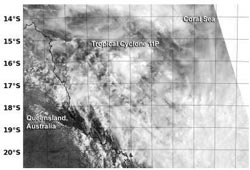NASA-NOAA satellite sees Tropical Cyclone 11P headed for Queensland

NASA-NOAA's Suomi NPP satellite captured this image of Tropical Cyclone 11P on Jan. 28 at 04:19 UTC, revealing a more rounded circulation than the previous day, and bands of thunderstorms over the storm's southern semi-circle.<br><br>Credit: NASA/NOAA/NRL
The VIIRS instrument aboard Suomi NPP captured an image of 11P on January 28 at 04:19 UTC/Jan. 27 at 11:19 p.m. EST. The image showed a more rounded circulation than the previous day, and bands of thunderstorms over the storm's southern semi-circle.
The Australian Bureau of Meteorology or ABM has issued a Cyclone Warning for coastal and island communities from Cairns to St Lawrence, including Townsville and Mackay. A Cyclone Watch remained in effect for communities through the eastern interior including Charters Towers and Moranbah. For updated warnings and watches, please visit ABM's website at: http://www.bom.gov.au
11P was passing near Willis Island, and according to the Joint Typhoon Warning Center or JTWC, the radar there indicated that the low-level center was better organized, but bands of thunderstorms appeared fragmented and loosely organized.
At 1500 UTC/10 a.m. EST on January 29, Tropical Cyclone 11P had maximum sustained winds near 35 knots/40 mph/62 kph. It was centered 247 nautical miles/284.2 miles/457.5 km east of Cairns, Australia, near 17.1 south and 149.8 east. Tropical Cyclone 11P is moving to the southwest at 6 knots/6.9 mph/11.1 kph.
The JTWC expects 11P to strengthen to 50 knots before making landfall. The JTWC forecast calls for landfall around 0000 UTC on January 31/7 p.m. EST on January 30 and the ABM forecast calls for 11P to cross the Queensland coast between Lucinda and Proserpine on January 31, Friday morning.
Media Contact
More Information:
http://www.nasa.govAll latest news from the category: Earth Sciences
Earth Sciences (also referred to as Geosciences), which deals with basic issues surrounding our planet, plays a vital role in the area of energy and raw materials supply.
Earth Sciences comprises subjects such as geology, geography, geological informatics, paleontology, mineralogy, petrography, crystallography, geophysics, geodesy, glaciology, cartography, photogrammetry, meteorology and seismology, early-warning systems, earthquake research and polar research.
Newest articles

Properties of new materials for microchips
… can now be measured well. Reseachers of Delft University of Technology demonstrated measuring performance properties of ultrathin silicon membranes. Making ever smaller and more powerful chips requires new ultrathin…

Floating solar’s potential
… to support sustainable development by addressing climate, water, and energy goals holistically. A new study published this week in Nature Energy raises the potential for floating solar photovoltaics (FPV)…

Skyrmions move at record speeds
… a step towards the computing of the future. An international research team led by scientists from the CNRS1 has discovered that the magnetic nanobubbles2 known as skyrmions can be…




















